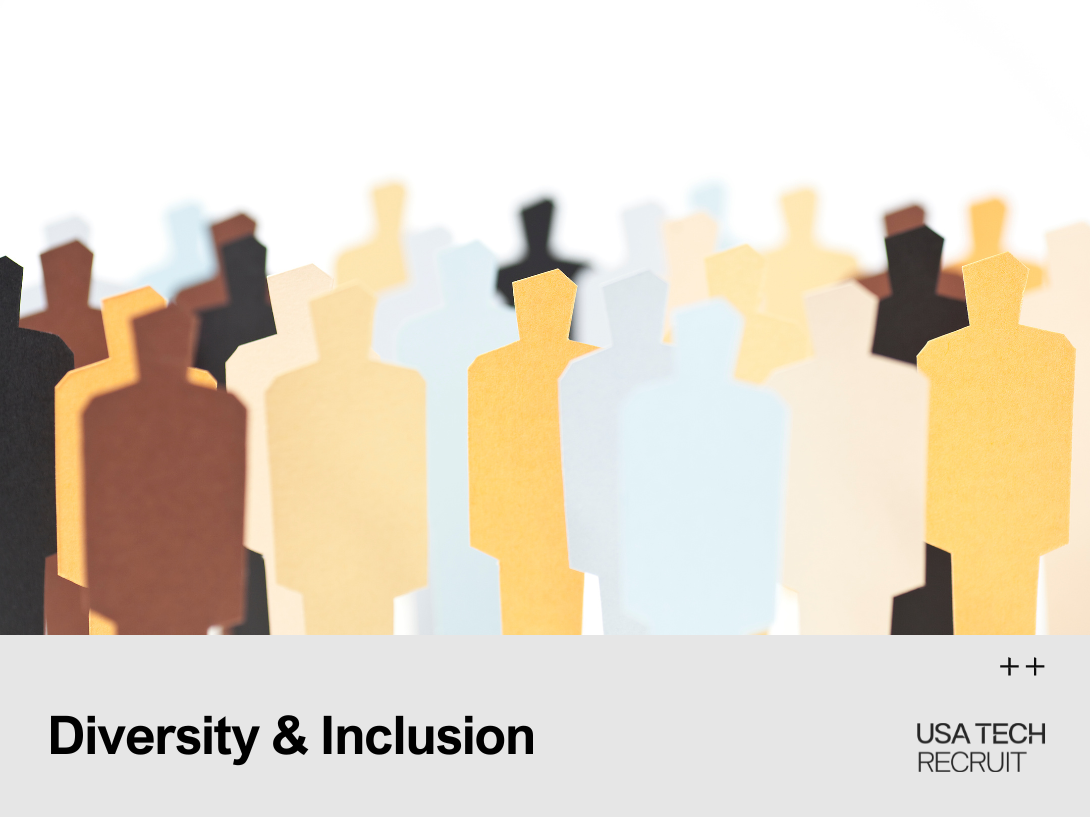Diversity and Inclusion

In this article:
Are Your Diversity & Inclusion (D&I) Policies Securing or Costing You the Best Talent?
The last few years have seen U.S. tech workers gain bargaining power in the labor market.
Not only are tech companies struggling to hire skilled workers, but more and more employees are thinking of resigning because of a lack of diversity in their current organization.
In 2022, it doesn’t matter how big your company is, or for how long it has been serving the tech industry: employers can no longer ignore the business case for Diversity & Inclusion (D&I).
Having said that, D&I is not just something employers have to do to retain the best tech talent.
Whether you’re implementing D&I in your company policies, embracing the Responsible Tech movement, or venturing into the social impact sector, here are 10 reasons why D&I will help your business stay competitive in the U.S. tech industry, optimizing employee performance, maximizing revenues, winning customer loyalty, and much more…
D&I is an important business matter
It goes without saying that promoting D&I is a moral duty that applies to all realms of life. However, in the workplace, D&I is also a key business matter, and should never be about ticking a box in a recruitment form.
Creating a workplace where professionals from all backgrounds feel they belong is vital. Otherwise, your employees might leave, with the financial resources and time you invested in recruiting and training them going wasted. And when it comes to the tech industry, the numbers suggest that this is already happening to many U.S. employers.
Tech workers want more diversity in the workplace
Compared to the rest of the U.S. private sector, the levels of ethnic and gender diversity across the tech workforce are infamously low.
African American workers comprise 13% of the U.S. workforce but only 8% of tech occupations. Similarly, Hispanic workers represent 16% of the U.S. workforce but only 7% of tech occupations.
Nationally, only 26% of tech occupations are filled by women, compared to 49% of positions in the rest of the private sector. Things get worse at the top of the executive ladder, where 84% of tech executives are white and 80% are men.
However, there are signs that things are changing for the better.
Two major events have recently taken the job market by storm:
The Great Resignation
The Great Resignation has seen the quit rate among U.S. workers grow to unprecedented levels. More than half of the American workforce are considering quitting their job in the next 12 months.
These numbers are even higher among tech workers.
According to a survey by TalentLMS and Workable, last August 72% of U.S. technologists were thinking of quitting their jobs in the next 12 months, compared to 55% of the overall U.S. workforce.
The Great Rehiring
The Great Resignation comes with the very opposite trend, the Great Rehiring. Due to rising levels of work vacancies, only in July 2021 U.S. employers struggled to fill nearly 11 million job openings.
With a record high of workers thinking of quitting their job and employers struggling to fill the workforce gap, HR experts claim that tech workers are now advantaged in the job market, as they are in a position to make employers hear their demands.
Needless to say, one of these demands is more diversity.
A recent CompTIA survey, found that 53% of US-based IT workers believe that there is more diversity in the rest of their organization than within their IT department.
According to Dice’s Equality in Tech Report, 35% of female tech workers are dissatisfied with their compensation, and nearly half of them report feeling underpaid compared to their male colleagues.
Retaining an increasingly dissatisfied workforce by implementing D&I policies should be one of the top priorities for all tech companies.
D&I equals a wider pool of tech talent
Besides facilitating employee retention, the most obvious benefit of implementing D&I is having a wider pool of talent to choose from.
Many companies focus their recruiting on traditional hubs like the San Francisco Bay Area, New York City, or North Carolina’s Research Triangle.
This strategy is understandable but can limit your options.
Many talented technologists don’t live in traditionally tech-heavy metropolitan areas.
After all, the country’s leading tech universities are not concentrated solely in the states of California, Massachusetts, and New York.
‘Under-the-radar’ tech cities like Atlanta, Baltimore, Boston, and Seattle can provide your business with not only as competent a pipeline of talent as the major tech hubs but also a more diverse workforce.
For a detailed guide to the country’s top tech hubs, including the hottest up-and-coming cities with solid pipelines of diverse talent, have a look at our Definitive Guide to U.S. Tech Hubs.
Diverse workplaces are more productive
Study after study has shown that a diverse and inclusive workplace has a direct impact on productivity throughout the entire organization.
Here are some findings from McKinsey’s Diversity Wins Report:
- Companies that employ more than 30% of women in their executive teams are more likely to outperform competitors with 10-30% female executives.
- There is a 48% performance differential between the most and least gender-diverse companies.
- Profitability wise, companies in the top quartile for gender diversity outperform those in the bottom quartile by 36%.
- There is a higher likelihood of outperformance with ethnically diverse workforces than those only diverse by gender.
Diverse workforces generate more revenue
It seems that enriching the workplace with a diverse range of political beliefs, ethnicities, sexual orientations, religions, classes, and gender identities brings higher revenues.
According to Deloitte, highly diverse companies can enjoy up to 2.3 times higher cash flows per employee.
Similarly, a BCG study found that companies with diverse management teams experience a 19% increase in revenues compared to less diverse competitors.
D&I strategies support positive brand sentiment
Consumers today expect that tech products and services meet their specific lifestyle needs and preferences.
Implementing D&I in your company policies enables your business to build customer loyalty and grow market share by reaching out to more diverse, better targeted, and highly remunerative markets.
Take women alone, for example.
In the U.S., female consumers report that they feel majorly underserved. And yet, women make up more than half of the population, controlling a staggering 85% of consumer spending and with their purchasing power ranging from $5 trillion to $15 trillion annually.
You risk being left behind
In 2014, top employers like Apple, Facebook, Google, Microsoft and Twitter acknowledged the diversity gap in the industry and made it a public goal to resolve the issue.
For the past seven years, these companies have published annual reports sharing data on their diversity-inclusion improvements.
The last few years have also seen a wide range of stakeholders embrace Responsible Tech, a movement that aims to promote ethical awareness across the tech workforce.
For example, Mozilla’s Responsible Computer Science Challenge aims to add ethics training to computer science curricula.
Leading tech companies have also established a chart of ethical principles, with the likes of Cisco, Google, IBM, Microsoft, NEC and Salesforce integrating into their organizations Responsible Tech positions, such as: Fairness AI Engineer; Machine Learning Ethics, Transparency & Accountability Engineering Manager; AI Ethics Data Science Analyst; Inclusive Design UX Researcher; Public Interest Cybersecurity Program Director.
Small businesses also benefit from D&I
Small business owners might give up on D&I on the assumption that its implementation requires big budgets, complex recruitment strategies, and other time-consuming processes.
D&I might come easier for the big players but there are several resources out there that can help you implement it in a small tech establishment.
For example, the National Center for Women & Information Technology brings together over 1,500 leader organizations to help increase the participation of girls and women in the field of computing.
Other tech organizations working toward a more inclusive workplace include:
- The American Indian Science and Engineering Society (AISES)
- Black Data Processing Associates (BDPA)
- Black & Brown Founders
- Black Girls Code
- Blacks in Technology
- CODE2040
- DigitalUndivided
- Information Technology Senior Management Forum (ITSMF)
- Lesbians Who Tech
- LGBTQ Tech
- National Action Council for Minorities in Engineering
- National Society of Black Engineers (NSBE)
- Nonprofit Technology Enterprise Network (NTEN)
- Opportunity Hub (OHUB)
- Out in Tech
- Trans*H4ck
- Wonder Women Tech
And then, there are many certifications supporting businesses that employ workers from unrepresented groups, such as:
- Woman Business Enterprise (WBE) certification is a gender-specific certification for women-owned businesses.
- Women-Owned Small Business (WOSB) certification is required for a specific federal purchasing program that has a set-aside quota for women-owned businesses.
- EDWOSB certification is required for the federal purchasing program mentioned above for disadvantaged businesses.
- The 8(a) designation is a business development/mentoring program offered by the Small Business Administration for a company that is considered disadvantaged.
- Small Disadvantaged Business (SDB) certification is for businesses that are 51% owned by one or more individuals who are both socially and economically disadvantaged but not participating in the 8(a) programs.
- Minority Business Enterprise (MBE) certification is race-based for minority-owned businesses.
- LGBT-owned Business Enterprise certification. The NGLCC is the exclusive, third-party certification body that verifies that eligible businesses are majority-owned by LGBT individuals, and subsequently grants LGBT Business Enterprise® (LGBTBE®) designation to such businesses as part of its LGBT Supplier Diversity.
Tapping into the social impact market sector
Technology has a key role to play in promoting D&I across the whole of society. Via innovative tech products and services, so-called ‘social impact’ start-ups have the power to mitigate critical social issues, such as unequal access to education, health, employment, and more.
Due to market fragmentation, estimates about the size of the social impact sector vary greatly but industry experts tend to agree that growth here is substantial and constant.
Crunchbase tracks the world’s social impact startups through portfolio updates from 3,500 global investment firms.
As of January 2022, the Crunchbase Social Impact Hub included 1,317 social impact startups, which had raised $2.3bn of funding.
The Global Impact Tech Alliance estimates that $2 billion was invested in impact tech startups in 2019 alone. This is a 10-time increase in 5 years and an overall 50% growth pattern.
According to the Global Impact Investing Network (GIIN), there are about 1,720 organizations now involved in managing funds for social impact enterprises.
In 2020, a GIIN survey of 294 global impact-investing organizations found that nearly 7 in 10 respondents expected social impact investing to expand steadily in the coming years.
———–
We hope you’ve found this article useful and supportive of your efforts to implement D&I policies in your workplace.
We are niche technology recruitment specialists matching diverse and innovative technology teams with the most sought after, hard-to-reach, talent. If you would like to find out more about working with us, please don’t hesitate to get in touch.
And hey, if you did find this article helpful, please don’t be afraid to share it on your social networks!
About the author
Ruggero Galtarossa is a PHD Researcher with a background in Journalism and Sociology. He studied at Cambridge University, England, and has worked as a content creator for Incubeta, an international team of experts in marketing, technology, data, and creative. He currently works as PHD Researcher and technology writer.


